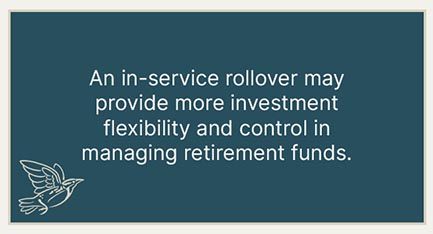Employer Retirement Plans can be excellent vehicles to help save for retirement. Money is typically invested on a pre-tax basis and then grows on a tax-deferred basis. Employers often provide a matching contribution for employee 401(k) contributions up to a certain percentage.
Most employees wait until retirement or a job change to consider rolling over their balance into an Individual Retirement Account (IRA). But not all plans are created equal, and some plans offer only limited investment options. Many plans offer the option for in-service withdrawals allowing current employees to rollover all or some of their balance tax-free into an IRA. An in-service rollover may provide more investment flexibility and control in managing retirement funds. This may be an attractive option when retirement is on the horizon.

Employees who are at least 59½ years old will avoid the 10% penalty on any money moved and will not be required to pay the deferred taxes on the balance if rolled over to an IRA. Requirements for in-service rollovers are specific to each plan; your plan provider or employer can let you know if it is an option and what criteria must be met. While rarer, some employers may stop you from being able to contribute to their 401(k) plan for a period after the rollover. You should also examine the fee structure of both arrangements, any Net Unrealized Appreciation (NUA) tax impacts, and differences in creditor protection.
Please consult your tax advisor, as well as your plan provider, regarding the tax implications of an in-service rollover and whether it is a strategy that is appropriate for your situation. We can help you determine what questions to ask.

